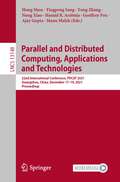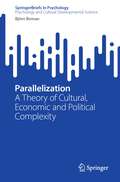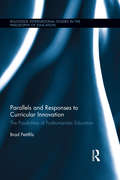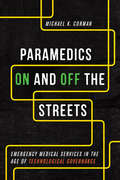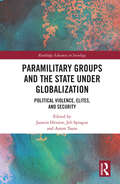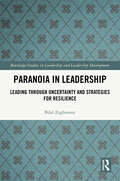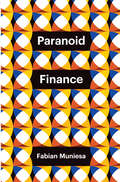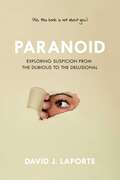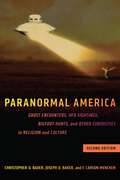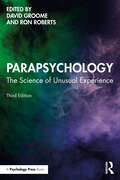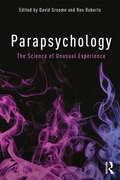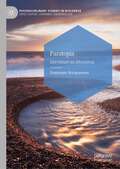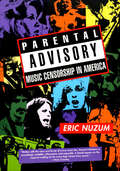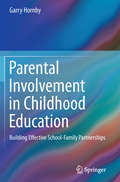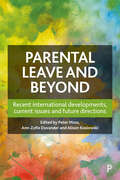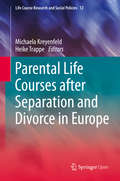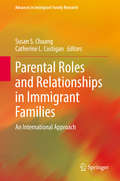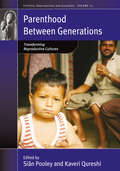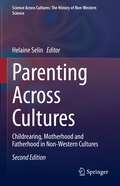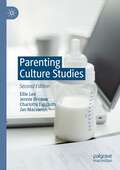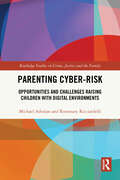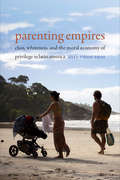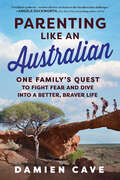- Table View
- List View
Parallel and Distributed Computing, Applications and Technologies: 22nd International Conference, PDCAT 2021, Guangzhou, China, December 17–19, 2021, Proceedings (Lecture Notes in Computer Science #13148)
by Ajay Gupta Hamid R. Arabnia Hong Shen Yong Zhang Nong Xiao Geoffrey Fox Yingpeng Sang Manu MalekThis book constitutes the proceedings of the 22nd International Conference on Parallel and Distributed Computing, Applications, and Technologies, PDCAT 2021, which took place in Guangzhou, China, during December 17-19, 2021. The 24 full papers and 34 short papers included in this volume were carefully reviewed and selected from 97 submissions. The papers are categorized into the following topical sub-headings: networking and architectures, software systems and technologies, algorithms and applications, and security and privacy.
Parallele Welten der Digitalisierung im Betrieb
by Dirk Baecker Uwe ElsholzDie Digitalisierung der Arbeit im Betrieb ist nicht nur eine Frage technischer Lösungen für bekannte Probleme. Viel weitreichender sind kaum beherrschte Lösungen für noch unklare Probleme. An der Maschine wird Arbeit zum Lernen. Im Betrieb wird Kommunikation zur Methode. Innovation wird zum Versuch, mit agilen Netzwerken Schritt zu halten, die permanent neue Aspekte aufrufen. Datenverarbeitung, so trocken es klingt, wird zum Medium, in dem Arbeit, Lernen und Betrieb neu gedacht werden müssen. Der vorliegende Band macht dazu aus soziologischer und berufspädagogischer Sicht einige Angebote. Der Zeitpunkt ist vermutlich gut gewählt. Internetkonzerne arbeiten an intelligenten Lösungen betrieblicher Prozesse, die diese schon bald zur Infrastruktur einer Gesellschaft werden lassen, die dann längst mit anderen Themen beschäftigt sein wird.
Parallelization: A Theory of Cultural, Economic and Political Complexity (SpringerBriefs in Psychology)
by Björn BomanThis SpringerBrief is an extension of the article "Parallelization: the fourth leg of cultural globalization theory" (Integrative Psychological and Behavioral Science, 2021) by Dr. Björn Boman. The original article consisted of four main examples of parallelization, and has been expanded to include chapters on Korea, Russia-Ukraine, and Georgia. This book points to the relations between oppositely directed processes and the need for theoretical modelling of complex societal processes.
Parallels and Responses to Curricular Innovation: The Possibilities of Posthumanistic Education (Routledge International Studies in the Philosophy of Education #36)
by Brad PetitfilsThis volume explores two radical shifts in history and subsequent responses in curricular spaces: the move from oral to print culture during the transition between the 15th and 16th centuries and the rise of the Jesuits, and the move from print to digital culture during the transition between the 20th and 21st centuries and the rise of what the philosopher Jean Baudrillard called "hyperreality." The curricular innovation that accompanied the first shift is considered through the rise of the Society of Jesus (the Jesuits). These men created the first "global network" of education, and developed a humanistic curriculum designed to help students navigate a complicated era of the known (human-centered) and unknown (God-centered) universe. The curricular innovation that is proposed for the current shift is guided by the question: What should be the role of undergraduate education become in the 21st century? Today, the tension between the known and unknown universe is concentrated on the interrelationships between our embodied spaces and our digitally mediated ones. As a result, today’s undergraduate students should be challenged to understand how—in the objectively focused, commodified, STEM-centric landscape of higher education—the human subject is decentered by the forces of hyperreality, and in turn, how the human subject might be recentered to balance our humanness with the new realities of digital living. Therein, one finds the possibility of posthumanistic education.
Paramedics On and Off the Streets: Emergency Medical Services in the Age of Technological Governance
by Michael K. CormanIn Paramedics On and Off the Streets, Michael K. Corman embarks on an institutional ethnography of the complex, mundane, intricate, and exhilarating work of paramedics in Calgary, Alberta. Corman’s comprehensive research includes more than 200 hours of participant observation ride-alongs with paramedics over a period of eleven months, more than one hundred first hand interviews with paramedics, and thirty-six interviews with other emergency medical personnel including administrators, call-takers and dispatchers, nurses, and doctors. At the heart of this ethnography are questions about the role of paramedics in urban environments, the role of information and communication technologies in contemporary health care governance, and the organization and accountability of pre-hospital medical services. Paramedics On and Off the Streets is the first institutional ethnography to explore the role and increasing importance of paramedics in our healthcare system. It takes readers on a journey into the everyday lives of EMS personnel and provides an in-depth sociological analysis of the work of pre-hospital health care professionals in the twenty-first century.
Paramilitary Groups and the State under Globalization: Political Violence, Elites, and Security (Routledge Advances in Sociology)
by Jeb Sprague Jasmin Hristov Aaron TaussThis book examines the phenomenon of paramilitarism across Latin America and the Caribbean, Eastern Europe, Africa, and Asia, offering a nuanced perspective while identifying key patterns in the way paramilitary violence is implicated in processes of capital accumulation, state-building, and the reproduction of social power. Paramilitary violence, a key modality of coercion in the era of globalization, has been pursued by states and dominant classes in the Global South, to reproduce or extend their power over subaltern groups. Paramilitary groups are responsible for atrocities, including extrajudicial executions, disappearances, torture, rape, and forced displacement. The book integrates empirically rich investigations into an emergent theory of political violence, capturing the relationship between parastatal armed actors, capital, and the state. The analysis sheds light on globally relevant phenomena such as the end of the Cold War, the shifting role of US hegemony, and evolving nature of the nation-state. The book is suitable for academics, graduate and upper-year undergraduate students, and policy-makers in development, human rights, and violence prevention. Given its interdisciplinary subject, it appeals to scholars from a wide range of disciplines, including political science, sociology, political anthropology, development, peace and conflict, security and terrorism, international relations, and global studies.
Paranoia in Leadership: Leading Through Uncertainty and Strategies for Resilience (Routledge Studies in Leadership and Leadership Development)
by Bilal ZaghmoutLeadership has emerged as a cornerstone of progress and transformation in organizations and societies in a world marked by constant change and ambiguity. However, one of the most formidable challenges leaders face is paranoia in leadership. This book is a profound exploration of this enigmatic phenomenon that plagues leaders and organisations, offering insights, solutions, and guidance for those navigating the complex terrain of leadership. With its unique focus on navigating paranoia within the context of leadership, this book delves explicitly into the nuanced challenge of paranoia. It offers practical insights and strategies for leaders to navigate and thrive in uncertain environments. It dissects the multifaceted nature of paranoia in leadership, delves into its psychological underpinnings, and provides practical strategies for mitigating its impact. By offering a comprehensive understanding of how to lead with resilience and trust, the book empowers leaders to confidently navigate the complexities of leadership in a world marked by uncertainty. It will be of interest to researchers, academics, practitioners, and students in the fields of leadership, organisational studies, psychology, and sociology.
Paranoid Finance (Theory Redux)
by Fabian MuniesaThere is a link between finance and paranoia, and that link may well be inescapable. At the core of financial imagination lies a notion of value – of ‘value creation’ – that is loaded with trouble. This is the trouble of a fragile metaphor: a metaphor of fecund money and future return, of true value and false value, of true value that should be protected from the perils of dilapidation, expropriation and speculation, but whose substance is in fact nowhere to be found. Contemporary conspiratorial, millennialist discourse on money, banking and wealth does not embody a delirious misrepresentation of the logic of finance: rather, it exacerbates the paranoid potentials inherent in mainstream financial imagination. This is the radical hypothesis developed in this book: that of paranoid finance as a sedimentation of the demons that haunt the conventional categories of financial value. Tutorials abound today that guarantee access to secret knowledge about the financial system, to magical currencies that release eternal returns, to legal schemes conducive to personal sovereignty, and to a way out of economic enslavement. They often combine disparate elements of esotericism, conspiratorialism, antisemitism, populism, libertarianism or spiritualism. But as Muniesa shows, they also provide a testbed for a critique of the limits of financial imagination.
Paranoid Pedagogies
by Jason J. Wallin Jennifer A. SandlinThis edited book explores the under-analyzed significance and function of paranoia as a psychological habitus of the contemporary educational and social moment. The editors and contributors argue that the desire for epistemological truth beyond uncertainty characteristic of paranoia continues to profoundly shape the aesthetic texture and imaginaries of educational thought and practice. Attending to the psychoanalytic, post-psychoanalytic, and critical significance of paranoia as a mode of engaging with the world, this book further inquires into the ways in which paranoia functions to shape the social order and the material desire of subjects operating within it. Furthermore, the book aims to understand how the paranoiac imaginary endemic to contemporary educational thought manifests itself throughout the social field and what issues it makes manifest for teachers, teacher educators, and academics working toward social transformation.
Paranoid: Exploring Suspicion from the Dubious to the Delusional
by David J. LaPorteFrom the pathological killer who gunned down the innocents at Virginia Tech to the average citizen who suspects the government is monitoring phone calls, the signs of suspiciousness and paranoia are all around us. In this comprehensive overview of an increasingly serious problem, an experienced psychologist and researcher describes what paranoia is, how and why it manifests itself, and the many forms it takes, including stalking, pathological jealousy, as a reaction to post-traumatic stress disorder, and perhaps even militia movements. Using striking vignettes from the present and the past, each chapter illustrates specific manifestations of paranoia while also describing in layperson's terms the clinical analysis of the condition. Among the topics discussed are the evolutionary origins of our "suspiciousness system" and factors that can trigger it today, the connection between illicit drug usage and paranoid behavior, PTSD, violent expressions of paranoia, and options for treating various kinds of paranoia. The author emphasizes that life in post-9/11 America is a fertile environment for paranoia; in an era of computer hackers, omnipresent security cameras, NSA surveillance, and terrorism, "normal" people have good reasons to be suspicious as their sense of security and privacy is undermined. But in such an insecure atmosphere, everyday suspicion can easily be ratcheted up, resulting in paranoia and occasionally violent outbursts. He warns of a possible epidemic of paranoia and suggests public health measures that could be used to counteract this potentially dangerous trend. Whether you consider yourself susceptible to paranoia or know others who might be, this enlightening book will help you understand the many factors that can distort your mental outlook.
Paranormal America (second edition): Ghost Encounters, UFO Sightings, Bigfoot Hunts, and Other Curiosities in Religion and Culture
by F. Carson Mencken Christopher D Bader Joseph O BakerAn &“engrossing and intellectually stimulating&” portrait of the countless Americans who believe in paranormal phenomena (Journal of Religion and Culture). Popular culture makes clear that there&’s a seemingly insatiable public appetite for information and entertainment about what we call the paranormal, supernatural, or mystical. But how many Americans believe in the paranormal, and who are they? Based on extensive research and their own unique experiences, Christopher Bader, Joseph Baker, and Carson Mencken reveal that a significant number hold these beliefs, and that for better or worse, we undoubtedly live in a paranormal America.Paranormal America follows the authors as they participate in psychic and palm readings, have their auras photographed, join a Bigfoot hunt, follow a group of celebrity ghost hunters as they investigate claims of a haunted classroom, and visit a support group for alien abductees. The second edition also includes new and updated research based on findings from the Baylor Religion Survey regarding America&’s relationship with the paranormal. Drawing on these diverse and compelling sources of data, the book offers an engaging account of the social, personal, and statistical stories of American paranormal beliefs and experiences. It examines topics such as the popularity of paranormal beliefs in the United States, the ways in which these beliefs relate to each other, whether paranormal beliefs will give rise to a new religion, and how believers in the paranormal differ from &“average&” Americans. Brimming with fascinating anecdotes and provocative new findings, Paranormal America offers an entertaining yet authoritative examination of a growing segment of American religious culture. &“An engaging and eye-opening book that offers an abundance of new insights, dispelling some popular stereotypes and reaffirming others.&” —Roger Finke, Distinguished Professor of Sociology and Religious Studies, Pennsylvania State University
Parapsychology: The Science of Unusual Experience
by David Groome Ron RobertsThis new edition of Parapsychology continues to challenge and provoke readers with some of psychology’s most puzzling phenomena. Whether believers or sceptics, the book provides readers with the opportunity to further their understanding of the paranormal, bridging the gap between traditional psychology and fringe areas.With contributions from leading paranormal researchers, this edition has been thoroughly updated and includes new chapters on dreams, precognition and prediction of future events and anthropology. The book has been reorganised to help readers frame each phenomenon within the context of cognition, science and religion, and chapters are structured around science and experience, cognition and belief, religious belief and science, and further topics in parapsychology. The book covers a range of topics that can be considered parapsychological; including reincarnation, entity encounters, astrology, mediumship and near-death experiences.Providing a balanced introduction to parapsychology that explores the strengths and limitations of scientific investigation, this is essential reading for students and professionals in the field, along with anyone interested in learning more about the science of the paranormal.
Parapsychology: The Science of Unusual Experience (A\hodder Arnold Publication)
by David Groome Ron RobertsContaining contributions from leading paranormal researchers, this edition of Parapsychology continues to challenge and provoke readers with some of psychology’s most puzzling phenomena. Whether believers or sceptics, the book provides readers with the opportunity to further their understanding of the paranormal, bridging the gap between traditional psychology and its so-called fringe areas. Featuring updates to many of the original chapters, this book brings readers up to date with the wealth of radical research in the field. This edition also includes several new chapters, covering subjects as diverse as possession and exorcism, conspiracy theories, reincarnation, and religious belief, many of which are extremely relevant in the world today. Drawing on a range of research, the book provides a balanced introduction to parapsychology, exploring the strengths and limitations of scientific investigation itself. Parapsychology is for readers from a variety of backgrounds: professionals in the field, students, lay readers and anyone who wants to understand what the paranormal can tell us about ourselves. A variety of viewpoints are on offer, with the emphasis on the reader to make up their own mind. Prepared to be unsettled, again…
Paratopia: Literature as Discourse (Postdisciplinary Studies in Discourse)
by Dominique MaingueneauThis book presents Maingueneau’s notion of paratopia and its application to literary discourse. Unlike most discourse analysts, who pay little attention to literature, the author argues that a discourse analytical perspective allows us to challenge the usual separation between textual and contextual approaches to works. Considered as an impossible belonging, paratopia is a condition of possibility of literature, of the subjects who occupy a writer's position and of the use they make of language. To find their place as creators, writers must elaborate their own paratopia, they must give it shape and meaning. Their works must both construct a certain world and, through paratopic shifters, reflect and legitimise the conditions of their own appearance. Paratopia is an invariant of literature, but it takes different forms throughout history: writers draw on their paratopic potential to appropriate the resources made available to them by literary discourse in their own time. Today, the development of digital technologies and research on gender prompts us to take a different look at traditional forms of paratopia. The corpus includes canonical and recent texts, mainly from Western literature. It will be of interest to students and scholars in literary studies, discourse studies (discourse theory and discourse analysis), and sociology of culture.
Parental Advisory: Music Censorship in America
by Eric D. NuzumEverything You Ever Wanted To Know About The Music Your Parents Never Wanted You To HearBelieve it or not, music censorship in America did not begin with Tipper Gore's horrified reaction to her daughter's Prince album. The vilification of popular music by government and individuals has been going on for decades. Now, for the first time, Parental Advisory offers a thorough and complete chronicle of the music that has been challenged or suppressed -- by the people or the government -- in the United States.From Dean Martin's "Wham, Bam, Thank you Ma'am" to Marilyn Manson's Antichrist Superstar; from freedom fighters such as Frank Zappa and in-your-face rappers such a N.W.A. to crusaders such as Tipper Gore, this intelligent and entertaining book shows how censorship has crossed sexual, class, and ethnic lines, and how many see it as a de facto form of racism. With nearly one hundred fascinating photographs of musicians, record burning, and controversial cover art; illuminating sidebars; and a decade-by-decade timeline of important moments in censorship history, Parental Advisory is by turns frightening and hilarious -- but always revealing.
Parental Involvement in Childhood Education
by Garry HornbyThis book details methods for evaluating parental involvement in a child's education. It offers an evidence-based model for parental participation and an analysis of key interpersonal skills for effective work with parents.
Parental Leave and Beyond: Recent International Developments, Current Issues and Future Directions
by Peter Moss, Ann-Zofie Duvander and Alison KoslowskiThis volume brings together contributors from 18 countries to provide international perspectives on the politics of parental leave policies in different parts of the world. Initially looking at the politics of care leave policies in eight countries across Europe, the US, Latin America and Asia, the book moves on to consider a variety of key issues in depth, including gender equality, flexibility and challenges for fathers in using leave. In the final section of the book, contributors look beyond the early parenthood period to consider possible future directions for care leave policy in order to address the wider changes and challenges that our societies face.
Parental Life Courses after Separation and Divorce in Europe (Life Course Research and Social Policies #12)
by Michaela Kreyenfeld Heike TrappeThis open access book assembles landmark studies on divorce and separation in European countries, and how this affects the life of parents and children. It focuses on four major areas of post-separation lives, namely (1) economic conditions, (2) parent-child relationships, (3) parent and child well-being, and (4) health. Through studies from several European countries, the book showcases how legal regulations and social policies influence parental and child well-being after divorce and separation. It also illustrates how social policies are interwoven with the normative fabric of a country. For example, it is shown that father-child contact after separation is more intense in those countries which have adopted policies that encourage shared parenting. Correspondingly, countries that have adopted these regulations are at the forefront of more egalitarian gender role attitudes. Apart from a strong emphasis on the legal and social policy context, the studies in this volume adopt a longitudinal perspective and situate post-separation behaviour and well-being in the life course. The longitudinal perspective opens up new avenues for research to understand how behaviour and conditions prior or at divorce and separation affect later behaviour and well-being. As such this book is of special appeal to scholars of family research as well as to anyone interested in the role of divorce and separation in Europe in the 21st century.
Parental Roles and Relationships in Immigrant Families
by Susan S. Chuang Catherine L. CostiganThis insightful volume presents important new findings about parenting and parent-child relationships in ethnic and racial minority immigrant families. Prominent scholars in diverse fields focus on families from a wide range of ethnicities settling in Canada, China, Israel, Italy, the Netherlands, and the United States. Each chapter discusses parenting and parent-child relationships in a broader cultural context, presenting within-group and cross-cultural data that provide readers with a rich understanding of parental values, beliefs, and practices that influence children’s developmental outcomes in a new country. For example, topics of investigation include cultural variation in the role of fathers, parenting of young children across cultures, the socialization of academic and emotional development, as well as the interrelationships among stress, acculturation processes, and parent-child relationship dynamics.This timely reference: • explores immigration and families from a global, multidisciplinary perspective; • focuses on immigrant children and youth in the family context;• challenges long-held assumptions about parenting and immigrant families;• bridges the knowledge gap between immigrant and non-immigrant family studies;• describes innovative methodologies for studying immigrant family relationships; and• establishes the relevance of these data to the wider family literature. Parental Roles and Relationships in Immigrant Families is not only useful to researchers and to family therapists and social workers attending to immigrant families, but also highly informative for persons interested in shaping immigration policy at the local, national, and global levels.
Parenthood between Generations: Transforming Reproductive Cultures
by Siân Pooley Kaveri QureshiRecent literature has identified modern "parenting" as an expert-led practice-one which begins with pre-pregnancy decisions, entails distinct types of intimate relationships, places intense burdens on mothers and increasingly on fathers too. Exploring within diverse historical and global contexts how men and women make-and break-relations between generations when becoming parents, this volume brings together innovative qualitative research by anthropologists, historians, and sociologists. The chapters focus tightly on inter-generational transmission and demonstrate its importance for understanding how people become parents and rear children.
Parenting Across Cultures: Childrearing, Motherhood and Fatherhood in Non-Western Cultures (Science Across Cultures: The History of Non-Western Science #12)
by Helaine SelinThis second edition of Helaine Selin’s successful Parenting Across Cultures comes at a time where interest in parenting has increased across the world as a result of the COVID pandemic, as parents and children were put into different and often challenging conditions. This new edition, like the first, contains chapters from countries in Asia, Africa, and South America as well as from indigenous cultures of several Western countries. The chapters were revised to include new research in the post-pandemic world. They show that there is a strong connection between culture and parenting: there are differences in affection and distance, harshness and repression, and acceptance and criticism. Some parents insist on obedience; others are concerned with individual development. This clearly differs from parent to parent, but there is just as clearly a connection to culture, which these chapters explore. In addition to the chapters on individual countries, the second edition includes a section on the pandemic, as well as new research on parenting and technology, gender, religion, adoption, step parenting, divorce, single parents, racism, gay parents, disabilities, autism, eating habits, transgender, attachment, migration, bullying, and refugee resettlement.
Parenting Culture Studies
by Jennie Bristow Jan Macvarish Ellie Lee Charlotte FairclothNow in its second edition, Parenting Culture Studies seeks to understand how parenting is taken as a particular mode of childrearing that reflects broader social trends. Ten years after the initial volume's groundbreaking publication, the authors once again closely examine how the main aspects of parenting have been established, explored, and critically evaluated. Chapters revisit phenomena such as intensive parenting and politics around parenting, as well as controversial issues including policing pregnant women's bodies and parental determinism. In addition to updates throughout the volume, including those addressing literature that has built from the book’s original publication, the book features a new third part discussing parents dealing with risk assessment, school closures, contradictory care arrangements, and vaccine hesitancy during the COVID-19 pandemic.
Parenting Cyber-Risk: Opportunities and Challenges Raising Children with Digital Environments (Routledge Studies in Crime, Justice and the Family)
by Michael Adorjan Rosemary RicciardelliOn the back of their last book, Cyber-risk and Youth, and building on a new research project, Adorjan and Ricciardelli marshal current research to explore parenting in the digital age.Utilizing 70 original interviews from rural and urban area Canadian parents, the book provides an overview of research on “digital parenting” and illuminates the modern parental experience of managing children’s access to internet-connected technologies. The book explores parents’ experiences with cyberbullying and nonconsensual sexting, as well as concerns over breaches of privacy, screen time and internet addiction. It also investigates parents’ views regarding effective and ineffective strategies in mediation of technology and cyber-risk, including new directions such as restorative practices intended as a response to online conflict and harm. While framing their discussions among sociological theories, Adorjan and Ricciardelli also deliberately emphasize the gendered nature of the book’s discourses and encourage critical reflection of various online surveillance technologies, often marketed to mothers, to keep children safe.As such, Parenting Cyber-Risk is a standout research monograph which not only offers broad insight into 21st-century parenting challenges but also offers solutions. The book will be of interest to advanced undergraduate and postgraduate students studying criminology, sociology and any other related fields.
Parenting Empires: Class, Whiteness, and the Moral Economy of Privilege in Latin America
by Ana Yolanda Ramos-ZayasIn Parenting Empires, Ana Y. Ramos-Zayas focuses on the parenting practices of Latin American urban elites to analyze how everyday experiences of whiteness, privilege, and inequality reinforce national and hemispheric idioms of anti-corruption and austerity. Ramos-Zayas shows that for upper-class residents in the affluent neighborhoods of Ipanema (Rio de Janeiro) and El Condado (San Juan), parenting is particularly effective in providing moral grounding for neoliberal projects that disadvantage the overwhelmingly poor and racialized people who care for and teach their children. Wealthy parents in Ipanema and El Condado cultivate a liberal cosmopolitanism by living in multicultural city neighborhoods rather than gated suburban communities. Yet as Ramos-Zayas reveals, their parenting strategies, which stress spirituality, empathy, and equality, allow them to preserve and reproduce their white privilege. Defining this moral economy as “parenting empires,” she sheds light on how child-rearing practices permit urban elites in the Global South to sustain and profit from entrenched social and racial hierarchies.
Parenting Like an Australian: One Family's Quest to Fight Fear and Dive into a Better, Braver Life
by Damien Cave"A beautiful tale of one family trying to figure things out—and, at the same time, a brilliant synthesis of a century of psychological science on how all of us can learn to dive headfirst into challenges, grow and adapt, and ultimately do well in life." —Angela Duckworth, New York Times bestselling author of GritRaise kids to be strong, confident, and happy—by parenting the Australian wayDamien Cave and his wife Diana thought they understood what it meant to take risks. As two journalists who traveled the world covering pressing international stories, they were convinced they had seen it all; that is, until they moved to Australia. Suddenly, their kids were being thrown into giant Pacific waves in intensive lifeguard bootcamps, and they were expected to be present and participating instead of obsessing about work or politics. They soon noticed what seemed to be a societal surrender of control to nature and community. In other words? Their American customs were completely disrupted. Living their new beachside life didn't end up being a relaxing retreat, but instead caused a complete reevaluation of the ways they acted as people and parents—and it all had to do with taking unexpected risks and learning how to manage them.New York Times Australia Bureau Chief Damien Cave delivers an impactful and informative account of how risk taking in parenting, and in all aspects of life, creates happier, healthier individuals and communities. Cave's exploration of Australian parenting culture, through gripping research and storytelling, will have you questioning everything you thought you knew about safety, risk, parenting, and, ultimately, being human."An illuminating parenting guide, a takedown of America's self-esteem industrial complex, and a deep study of contrasts between the Australian and American minds." —Pamela Druckerman, New York Times bestselling author of Bringing Up Bébe
